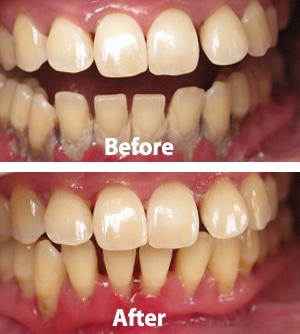Laser For Periodontal Disease

Periodontal disease, a chronic infection of the gums and bone supporting the teeth, is a common condition that can lead to tooth loss if left untreated. Traditional treatments for periodontal disease, such as scaling and root planing, can be effective but often require multiple sessions and may not always eliminate the infection. Recent advancements in dental technology have introduced the use of lasers as a promising treatment option for periodontal disease. Laser therapy for periodontal disease has gained popularity due to its potential to selectively target and eliminate infected tissue, reduce bleeding and inflammation, and promote healing.
The concept of using lasers in dentistry dates back to the 1960s, but it wasn’t until the 1990s that laser treatment for periodontal disease began to gain traction. The first laser specifically designed for periodontal therapy was approved by the FDA in 2004. Since then, numerous studies have investigated the efficacy and safety of laser treatment for periodontal disease, with encouraging results. Laser therapy has been shown to be effective in reducing pocket depths, improving clinical attachment levels, and decreasing bleeding on probing.
One of the primary advantages of laser treatment for periodontal disease is its ability to selectively target and eliminate infected tissue. Laser energy can be adjusted to specific wavelengths that are absorbed by the infected tissue, allowing for precise removal of diseased tissue while sparing healthy tissue. This selective targeting can lead to less damage to surrounding tissue and reduced risk of complications. Additionally, laser treatment can help to reduce bleeding and inflammation, making it an attractive option for patients who are apprehensive about traditional surgical treatments.
There are several types of lasers that can be used for periodontal therapy, including the Nd:YAG laser, diode laser, and Er:YAG laser. Each type of laser has its own unique characteristics and advantages, and the choice of laser depends on the specific needs of the patient and the preferences of the dentist. The Nd:YAG laser, for example, is commonly used for periodontal therapy due to its deep penetration and ability to coagulate tissue. The diode laser, on the other hand, is often used for its precision and ability to target specific areas.
The procedure for laser treatment of periodontal disease typically involves several steps. First, the dentist will conduct a thorough examination of the patient’s mouth to determine the extent of the disease. This may involve taking X-rays, measuring pocket depths, and assessing the overall health of the gums and teeth. Once the extent of the disease is determined, the dentist will develop a treatment plan that may involve laser therapy alone or in combination with other treatments, such as scaling and root planing.
The laser treatment itself is typically performed under local anesthesia to minimize discomfort. The dentist will use a specialized laser instrument to deliver the laser energy to the infected tissue. The laser energy is absorbed by the infected tissue, causing it to vaporize and be removed. The procedure can take anywhere from 30 minutes to several hours, depending on the extent of the disease and the number of teeth being treated.
After the procedure, patients may experience some mild discomfort, swelling, and bleeding. However, these symptoms are typically short-lived and can be managed with over-the-counter pain medication and ice packs. Patients are also advised to follow a soft food diet for several days after the procedure and to avoid strenuous activities.
In addition to its therapeutic benefits, laser treatment for periodontal disease also offers several advantages over traditional treatments. For example, laser treatment can be less invasive and require fewer sessions than traditional scaling and root planing. Additionally, laser treatment can be more comfortable for patients, as it often requires less anesthesia and can result in less bleeding and swelling.
Despite its potential benefits, laser treatment for periodontal disease is not without its limitations and potential risks. One of the primary limitations of laser treatment is its cost, which can be significantly higher than traditional treatments. Additionally, laser treatment may not be suitable for all patients, particularly those with certain medical conditions or taking certain medications. Furthermore, the long-term efficacy and safety of laser treatment for periodontal disease are still being investigated, and more research is needed to fully understand its benefits and limitations.
What is the cost of laser treatment for periodontal disease?
+The cost of laser treatment for periodontal disease can vary depending on the specific treatment and the dentist performing the procedure. On average, the cost can range from $500 to $2,000 per session, with multiple sessions often required for optimal results.
Is laser treatment for periodontal disease covered by insurance?
+Insurance coverage for laser treatment of periodontal disease varies depending on the specific insurance plan and the patient's needs. Some insurance plans may cover a portion of the cost, while others may not cover it at all. It is best to check with the insurance provider to determine the extent of coverage.
How long does it take to recover from laser treatment for periodontal disease?
+Recovery from laser treatment for periodontal disease is typically quick, with most patients able to return to normal activities within a few days. However, it is recommended to avoid strenuous activities, such as heavy exercise or lifting, for at least a week after the procedure.
Can laser treatment for periodontal disease be used in combination with other treatments?
+Yes, laser treatment for periodontal disease can be used in combination with other treatments, such as scaling and root planing, to achieve optimal results. The dentist will determine the best treatment plan based on the patient's specific needs and the extent of the disease.
Is laser treatment for periodontal disease suitable for patients with certain medical conditions?
+Laser treatment for periodontal disease may not be suitable for patients with certain medical conditions, such as diabetes or bleeding disorders. It is essential to inform the dentist of any medical conditions or medications being taken before undergoing laser treatment.
In conclusion, laser treatment for periodontal disease offers a promising alternative to traditional treatments, with its ability to selectively target and eliminate infected tissue, reduce bleeding and inflammation, and promote healing. While it has its limitations and potential risks, laser treatment can be an effective and comfortable option for patients seeking to manage their periodontal disease. As with any medical treatment, it is essential to consult with a qualified dentist to determine the best course of treatment and to discuss any concerns or questions.

